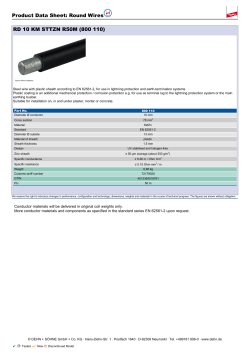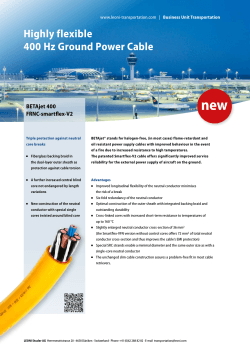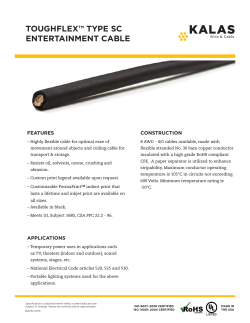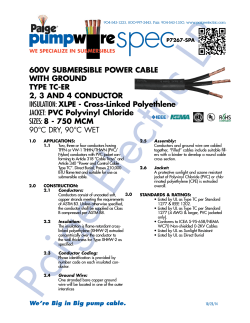
on conductor - IEEE Rural Electric Power Conference
2015 IEEE Rural Electric Power Conference Asheville, North Carolina Factors Affecting Conductor Motion Conductor Unit Weight (lbs. per ft.) Fault Current in Conductor (amperes) Duration of Fault Current (seconds) Conductor Spacing Conductor Tension & Sag Mechanical Damping Why Interest now in Conductor Motion? Larger substations that increase available fault currents. Closer conductor spacing in order to minimize aesthetic impact of overhead lines. Increased customer sensitivity to momentary interruptions and voltage dips. Increased conductor sag due to the use of larger conductors while maintaining distribution tension limits. Catenary Parameters and Basic Equation Figure 1: Catenary Parameters (Equation 1b) D = the sag of a level span. S = the span length. H = the conductor tension. w = the unit weight of the conductor. Magnetic Forces Between Conductors (Equation 2) F = the force in pounds per foot of conductor. d = the spacing between the conductors in feet. I = the symmetrical short-circuit current. Wind Forces on Conductors (Equation 3) d = the conductor diameter, in. VW = the wind speed, mph. FH = the horizontal wind force, lbs/ft. Conductor Displacement Due to Horizontal Forces Figure 2: Conductor Swing (Equation 4a) WC = the conductor weight per unit length, lbs/ft. (Equation 4b) XH = the horizontal deflection at midpoint of span, ft. D = the midpoint sag of conductor at specified wind and conductor temperature, ft. Calculation of Motion (Equation 2) (Equation 4a) (Equation 4b) Apply Equations 4a & 4b to determine displacement using initial force based on conductor ‘at rest’ position with Equation 2. Calculate displacement for 0.01 seconds. Apply Equation 2 for new horizontal separation and reiterate with Equations 4a & 4b. Continue iterations until limit is reached. Limit is when gravity vector equals vertical vector component of horizontal force acting on displaced conductor or horizontal position is reached. Also limit iterations to fault current duration. NESC Requirements for Horizontal Spacing NESC requirements are based principally on clearances to minimize contact during wind events. NESC requirements are basically the same as in NBS Handbook 81 (1961). Importance of Conductor Tension Typical 250' Span Conductor Final Sag - (IN.) Conductor Design 60°F Initial # 60°F 90°F 167°F 75% - 60°F Initial # 60°F 90°F 167°F 1/0 ACSR 1243 910 20.5 29.5 45.6 682 27.1 37.3 52.1 4/0 ACSR 2000 1394 26 36 52 1046 32.8 42.8 58.1 336 ACSR 2000 1172 38 49.1 72.2 879 46.1 56.3 77.8 556 ACSR 2000 1149 54.7 64 83.8 862 69.4 77.2 94 556 ACSR 3000 1812 39.8 50.6 73.4 1360 43.7 54 76.1 Why Worry about 167°F (75°C)? Conductor Ampacity Wind Angle Book* 90°** 45°** 0°** 1/0 ACSR 243 198 182 121 4/0 ACSR 366 294 271 180 336 ACSR 519 419 386 262 556 ACSR 711 571 526 369 All values at 75°C (167°F) conductor temperature with 2 FPS wind. * 25°C Ambient ** 40°C Ambient Values are combined effect of using 40°C (104°F) ambient and various wind angles. Typical RUS Structures Figure 4A: RUS C1 Phase-to-Phase faults more critical. Figure 4B: RUS DC-C1 Conductor Size Required for 10,000 AMP Fault Soft Drawn CU - Start Temp 40ºC Example of Structure for Phase-to-Ground Fault Figure 5: Conductor Conflict for a C9 STRUCTURE Conductor Size Required for 14,500 AMP Fault Soft Drawn CU - Start Temp 40ºC Conductor Temperature Effect Conductor 3 kA - 58~ 10 kA - 10~ 1/0 ACSR @ 90°F 27" 37" (Horiz) 1/0 ACSR @ 75% & 167°F 45" 47" (Horiz) Time for Maximum Reverse Swing 3000 A for 58~ Conductor Return Time (sec.) Displacement (inches) 1/0 ACSR 1.45 - 1.82 27 - 45 4/0 ACSR 1.58 - 1.90 22 - 33 336 ACSR 1.79 - 2.14 25 - 41 556 ACSR 1.99 - 2.32 21 - 28 Conclusions Consider conductor temperature under load currents when determining maximum sags. Consider maximum operating sags and available short circuit currents when evaluating allowable span lengths, design tensions and conductor spacing. Include measurements of actual conductor sag/tension during inspections of conductor installations. When investigating the occurrence of apparent miscoordination, consider the possibility of conductor clash on the source side of suspected fault locations.
© Copyright 2025









